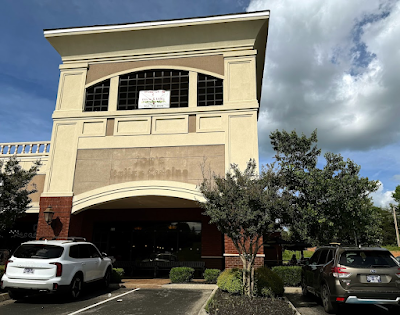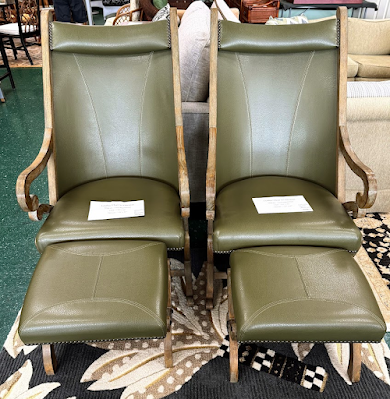...continuing with Bill and Bonnie's visit. Another meal out, this time it was Italian. Back in May I'd written a post for the blogsite about a new Italian Restaurant in close proximity to our home. It was promising and, since both Bonnie and Bill really like Italian food, we got dressed up before we headed out the door!
Laurie's sister Bonnie and her husband Bill, ready to head out for dinner...
Yours truly and Laurie (my better half), also ready to head out for dinner. And yes, I did dress up for dinner. The man in black with a collared shirt... I generally avoid restaurants where I have to wear long pants. If its over 50 F, I wear shorts! It's one of the 'privileges' of retirement... 
This is the Fork and Vine in Lenoir City Tennessee. They now have a permanent sign that replaced that white temporary signage shown in this earlier photograph. To see my earlier post regarding this restaurant, you can go to https://www.blogger.com/blog/post/edit/5617317794624015781/711400631634636564. As you will note on the faded signage below that temporary sign, this location was previously called Joe's Italian Cuisine.
My bad! A couple of posts earlier I'd negatively credited the first charcuterie board to the wrong restaurant, "Water into Wine". In reality, the first board shown above (termed a Salumi Board) was enjoyed at "Fork and Vine" prior to the arrival of our salads and entrees. At $15.00 it was indeed a good deal and the quality was there as well. The second charcuterie board is the one that should have been 'credited' to our experience at "Water into Wine".
FYI, Fork and Vines Salumi Board contained an assortment of meats and cheeses plus roasted red pepper hummus, sliced ciabatta bread and tangerine chili olives. For the record, I'm not a real fan of charcuterie boards but many people are including Laurie, Bonnie and Bill. I don't dislike them but I'd prefer focusing on the main courses or more singular appetizers...
Another Fork and Vine appetizer was their Drunken Mussels. ($15.00) The mussels were swimming in an amazing vodka and white wine sauce, with basil, garlic, tomatoes, and banana peppers. They were also accompanied by sliced ciabatta toast points with herb butter. Bread and herbed olive oil came with the meals and seconds were provided at no cost. The bread was invaluable for soaking up the mussels delectable sauce...
The only negative was that too many mussels hadn't opened up during the cooking process. It should have been caught in the kitchen.
Laurie ordered a side 'Julius Caesar' salad with her entree. Salads with an entree are $5.00 vs $12.00 for a dinner sized Caesar salad. Laurie really enjoyed her salad.
For her entree, Laurie ordered the Vodka Di Gallo. The fresh Creste di Gallo pasta came with a pink vodka cream sauce, onions, basil and mushrooms. Laurie added blackened 'colossal' shrimp to her main course. ($8.00) With the shrimp, her meal cost $24.00. Other add-on options included chicken, meatballs or Italian sausage. ($6.00) Laurie completely enjoyed her entree...and would order it again.
Bonnie also ordered a side salad with her entree. ($5.00) It came with mixed greens, tomato, red onion, carrots, cheese and croutons.
FYI, a total of 9 starters or appetizers are on the menu at Fork and Vine as are other salads...including dinner salads.
Bonnie ordered the 1809 Risotto...with creamy parmesan risotto, mushrooms, seared scallops and herb broccolini. ($28.00) The base of the cream sauce is a lemon wine cream. Bonnie enjoyed her entree and Laurie gave a big 'thumbs up' on the risotto.
As for Bill's entree, somehow we missed taking a photo of his 'seafood entree'. It was the Ciopinno Lenoir with mussels, clams, shrimp and fish simmered in at robust tomato based broth. ($24.00) It was served with grilled Ciabatta bread and Bill also added a Caesar salad to accompany his meal. He was happy with his choice for dinner and he completely cleaned his plate!
As for yours truly, I started my meal with a bowl of Italian Wedding Soup. No photo yet again. ($9.00/cup $5.00) It was very nice broth and it was loaded with little meatballs, spinach and pasta pearls.
I had a hankering for pizza so I ordered Fork and Vine's Wood Fired Pepperoni Pie. ($16.00) As per the menu it was made with fresh house made pizza sauce, mozzarella cheese and 'loaded with pepperoni'. Since my favorite pizza is a combination of Italian sausage and pepperoni, I asked that sausage be added to the toppings. No problem...same price too. It sure looked good!
As you may remember, Laurie and I have been searching for great pizza ever since we moved to East Tennessee. Sadly, we're still searching. My pizza's crust was soggy, the pizza sauce was bland...to me it lacked any Italian seasonings...and 'bland' carried on to the sausage and even the pepperoni. I took about half of my pizza home and 'dressed it up' a couple of days later. I added more pepperoni (spicier than than the original), extra mozzarella cheese to help re-moisturize the pie and Laurie sprinkled on some basic Italian seasoning. It was a much improved pizza with the changes we made...
Fork and Vine shows a lot of promise in a market basically devoid of quality Italian cuisine. Other than the pizza...and the unopened mussels...we were quite happy with our experience. We will return in the near future and try some other menu options. Fork and Vine Restaurant is located at 131 Kelsey Lane (visible from US Hwy 321) in Lenoir City. This restaurant is open from 11 AM until 10 PM Monday - Saturday and from 10 AM until 4 PM on Sunday. Phone: 865-317-1098. Fork and Vine's website is at https://fnvlenoir.com/. They are also on Facebook at https://www.facebook.com/p/Fork-Vine-Lenoir-City-61568667290284/.
We did not eat out for every meal or even every day during Bonnie and Bill's visit. Laurie took the above photo of myself, Bonnie and Bill enjoying a meal of ribeye steaks (medium rare), corn, sauteed squash, sweet and sour cucumbers and fresh bakery bread...plus a bottle of wine.Just click on any of the photos to enlarge them...
Thanks for stopping by for a visit and for those in and from the USA, have a HAPPY, HEALTHY AND SAFE JULY 4th!
Take Care, Big Daddy Dave

















































